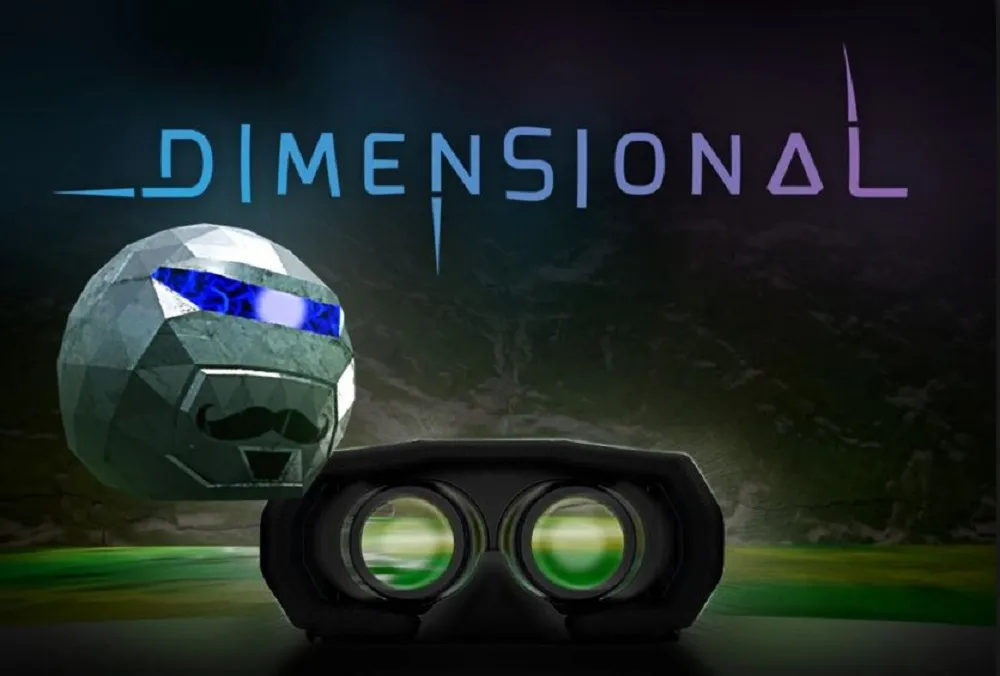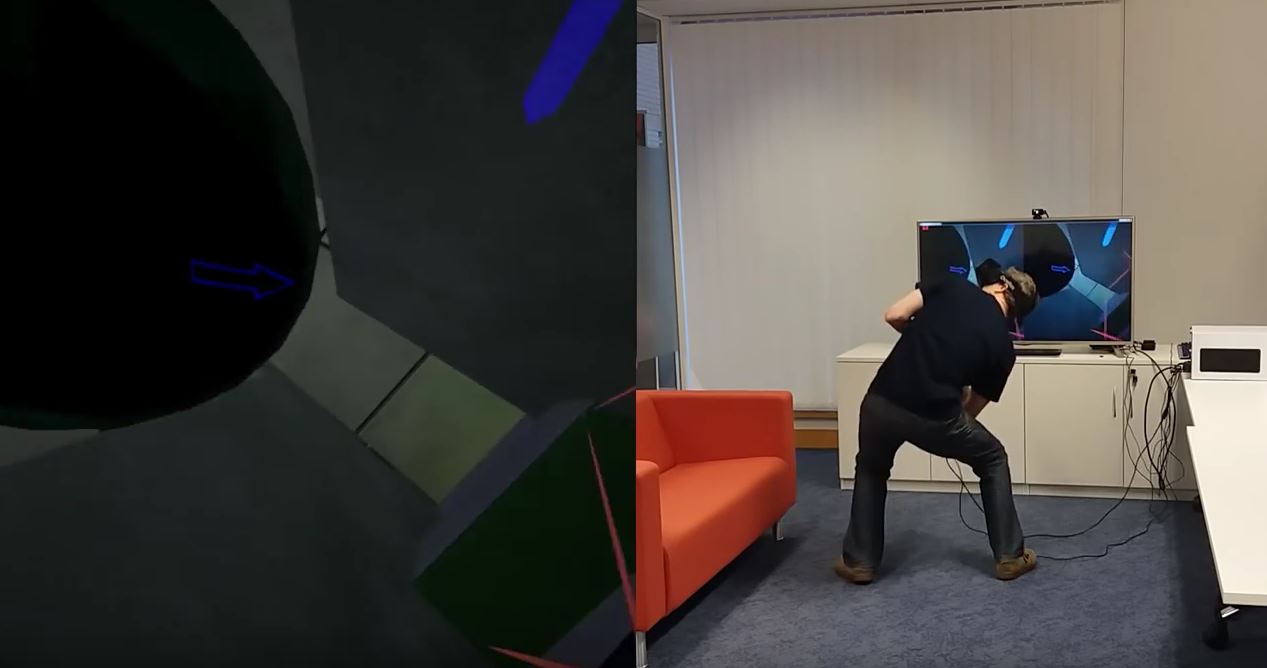Last year we covered a small tech demo experience called Play Pit from Brett Jackson, an independent game developer and designer. It utilized a mechanic that was very similar to the “Blink” system present in Cloudhead’s forthcoming HTC Vive launch title, The Gallery. Jackson has now branched off from Play Pit, “an early prototype for the locomotion system” to Dimensional, a project that builds on top of all the lessons he learned so far.
Dimensional is a first-person puzzle game built for the Oculus Rift and HTC Vive that’s been successfully funded on Kickstarter. At first glance, it seems awfully similar to the systems in place with Cloudhead’s Blink system, and that’s because they are. Play Pit was released before Cloudhead announced their Blink system, but the Blink system had clearly been in development already as well. Locomotion is such a major problem for VR games, it’s no surprise that two very similar features were in development simultaneously.
The core of the issue is that when your body and mind perceive motion – such as a character moving forward in a game – while you’re in virtual reality, but then your body doesn’t actually experience that physical movement, it can be very uncomfortable and nauseating. I’ve never had the unfortunate displeasure of that particular negative sensation, but it’s one of the biggest hurdles that many VR developers either ignore or design their games in a way to circumvent the issue. In Jackson’s case, he wanted to tackle it head-on and developed an entire game around the topic.
“One of the first things I did with my DK2 was load the Oculus Tuscany demo and position my camera so I could take a step and lean over the balcony,” Jackson said. “Just one step and a lean greatly intensified the feeling of being in a real space. I was hooked.” In one of my first real VR experiences, playing EVE: Valkyrie, I had a similarly revelatory moment while gazing about the cockpit and looking at the control panel.
After playing that demo, Jackson knew exactly what he needed to do in order to replicate that sensation as the cornerstone of an entire VR game. He was limited to the relatively limited hardware of the Rift DK2 and the even more limited physical office space that he was occupying, so it wasn’t easy.
“I knew that [a small space] was going to be a common problem so I concentrated on solutions that would work in very small spaces, but scale to larger areas,” Jackson explained. “Using the HMD’s positional tracking to mark the available space by simply walking around it seemed an obvious approach.” You essentially treat your living space as a transposed map of sorts. Walk around the room to trace the outline of your area and then that’s represented in the game as the space you have to navigate. It’s a simple solution that means even a small office space could theoretically allow you to physically traverse an entire game world.
By employing an instantaneous teleportation mechanic, Jackson is able to effectively eliminate the sensation of false movement that often leads to nausea. And what’s most impressive about it all is that this essentially allows for a loosely interpreted “room-scale” type experience with the Oculus Rift, even though that’s not officially supported. By simply using a starting position and tracking the device’s movement, Dimensional can accurately and reliably map your room and give you a small space to move around without worry for running into furniture.
Obviously, the biggest issue with this system however, is with repositioning. What if I am standing at the edge of my room’s boundary and I teleport forward facing a wall? I can’t move unless i just walk backwards and teleport again, but that’s not every convenient.
“I automated the rotation and positioning at special points-of-interest, so that you ended up facing the camera and therefore had optimum tracking” Jackson said. “I also allowed manual rotation and positioning prior to a teleport to give the freedom to explore as the player desired. It all felt so obvious I thought everyone would be doing it.”
But that isn’t necessarily a fool-proof system as overcoming game design challenges is often easier said than done. It can be an awfully inconvenient and cumbersome experience to constantly have to manually reposition yourself or have the game automatically force you to face in certain directions at all times. It limits your immersion and hampers your feeling of presence.
“I’m now on my third version of this mechanism,” Jackson said. “Dimensional fades out most of the world and drops you to a limbo state to perform the repositioning. This removes the problem of backing up through a wall or over a drop when moving to the new position. It also gets you to move to a new position without looking at your feet, which aren’t visible.”
Dimensional also allows for other type of standing interaction, such as leaning and ducking around objects, and you’ll be represented as your real-life height in the game. Jackson also started to implement audio tracking as a way for added immersion. By utilizing the HMD’s microphone, Dimensional not only recognizes and transmits your voice, but it can also hear the difference between speaking softly and loudly as well.
In the video above, Jackson plays through a short series of puzzles. In one situation, he demonstrates how speaking softly gets a droids attention in a calm way, but shouting startles the droid, causing it turn around quickly and start shooting. In another situation, he scared a droid causing it to malfunction so that he could get through an area.
While these are rudimentary examples of audio tracking in VR, the possibilities for interaction with non-playable characters is staggering. “It just makes sense that if you’re present in the world, the characters should be able to see and hear you,” Jackson said. “Even if a character can’t understand you, they can make eye contact when you talk and even look from your eyes to your mouth. They could stop talking when you interrupt them. They can react differently depending on whether you’re calm and quiet or loud and aggressive.”
Now that Dimensional is successfully funded, Jackson can finish up that experience and move forward with that momentum to try some of his other experiments. “ I’ve got pages of gameplay related experiences to test to see how they make players feel,” Jackson said. “Emotional responses increase immersion. The more you bring into a game that behaves as in real-life, such as physics-enabled objects, the more immersive it becomes.”
You can keep track of the latest developments regarding Dimensional on the game’s Kickstarter page or by voting for it on Steam Greenlight. If you own a DK2, you can also download and try out the demo for free.



























